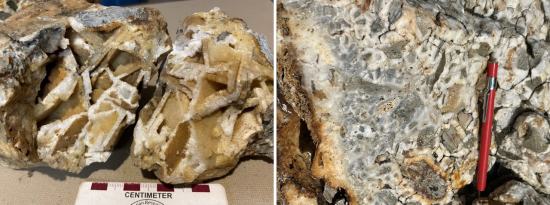Toronto, Ontario – March 7, 2022: Romios Gold Resources Inc. (“Romios Gold” or the “Company”) (TSX.V-RG; OTCQB: RMIOF; Frankfurt: D4R) is pleased to report on the results of the 2021 geological mapping and sampling program at its wholly owned, historic gold-producing Scossa Mine (“Scossa”) property in Pershing County, Nevada.
Highlights:
- Follow-up sampling in 2021 of the old shafts, pits and dumps along the veins returned assays ranging from trace to 23 g/t Au (see Fig. 1).
- Mapping of the vein textures in 2021 confirmed the presence of spectacular silica-coated open boxwork textures at the Angel Wing vein (Photo 1), a feature typical of the paleo-boiling zone level where gold begins to precipitate in epithermal gold veins, and extensive quartz-filled breccias at higher levels (see Photo 2).
- During vein formation, gold deposition generally begins at the boiling zone elevation and continues upwards from there, potentially for several hundred metres. The 2021 results are expected to enable Romios to locate the paleo-boiling zone level in each vein during drilling and vector in on the gold-silver zones.
- Bonanza grades occurred at surface on the Scossa 1-12 vein and in Romios’ past drilling, including 3.35m @ 180 g/t Au in DDH #2000-2 (See News Release). Although the veins are often < 2m wide, grades can be very high.
- The Cinnabar Prospect, located 1.3 km SE of the main Scossa vein swarm, was staked in 2020 and mapping of a 60m long trench there indicates that this showing is a highly altered fault structure locally mineralized with cinnabar. This low-temperature mercury mineral is often found in the uppermost levels of epithermal gold-silver veins just above the precious metals zone.
“Romios had the good fortune to acquire the Scossa Mine property at a time back when gold prices were less than $300 per ounce,” stated Stephen Burega, President. “And during the historic mining at Scossa, it became famous for the bonanza-grades of some ore shoots which were so rich in visible gold that the ore was stored in the bank vault in Lovelock. Our sampling and mapping in 2021, combined with the knowledge of where the historic mining activity was focussed, will be used to guide the next phases of drilling and define these mineralized shoots at depth and along strike,” he continued.
“Epithermal gold-silver veins like those at the Scossa property typically form when hydrothermal fluids under pressure begin to boil as they rise to an elevation shallow enough to overcome the hydrostatic pressure,” stated John Biczok, VP- Exploration. “Changes in the fluid due to boiling cause the gold and silver to precipitate and it can then be carried upwards in finger-like shoots at various intervals along the veins. These shoots can be very high-grade and it is important to determine where the mineralized shoots are versus the low-grade background vein material.”
Drilling by Romios in 2000 intersected 3 extremely high-grade intervals including: 3.35 m @ 180.22 g/t Au, 1.98 m @ 267.96 g/t Au, and 1.51 m @ 62.49 g/t Au plus 73.4 g/t Ag.
These drill programs also tested the veins at considerable depths (well below the paleo-boiling zone) and revealed that the veins were still present with good widths but the grades were low. This pattern reinforces the current belief that the best potential lies in the vein intervals above the paleo-boiling zone level indicated by the Angel Wing vein textures (see Photos 1 and 3). The Angel Wing vein is one of the 2 veins lowest in elevation on the property and any vein segments at or above this level are highly prospective for bonanza grade mineralization (see Figure 1, Photo 3).
Past mine production was from 5 epithermal veins concentrated in a 650m long x 450m wide area. Individual veins vary from 350m to more than 550m in length. Some of these veins have only been tested with 2 short drill holes and 2 of the shorter veins have had no drilling at all.

Photo 1 (left): Spectacular quartz-lined open boxwork texture from the Angel Wing vein, indicative of the boiling zone in vein formation. Photo 2 (right): Chalcedonic and drusy quartz infilling breccia vein, Scossa 1-12 vein.

Figure 1: Schematic cross-section of the main vein system at Scossa, looking north.

Photo 3: View from the West Vein looking east across the Scossa property.
Vein locations are approximate.
WEST VEIN: Mapping and sampling by Romios personnel has also upgraded the potential of the poorly exposed West vein system (see Fig. 1) that was not mined in the past. Located 215 m west of the main Scossa vein system, limited sampling of the scattered exposures of the West vein in the past returned low gold values. Mapping in 2021, however, located a swarm of small veins in outcrop that assayed 4.42 g/t Au, extending the apparent extent of the West vein by 150m and indicating that it may have better potential at shallow depths than previously known.
TAILINGS PILE: A 2m vertical channel sample was collected in 2021 from a small tailings pile at the apparent site of a former small processing mill beside the No. 4 Shaft vein near its intersection with the Noble Vein (see Fig. 1, Photo 3). This fine, sand-like, “leftover” material from the milling process assayed 8.6 g/t Au and 8.3 g/t Ag, suggesting that the grades of the veins mined in the past must have been quite substantial.
THE CINNABAR PROSPECT: Located 1.3 km SE of the main Scossa vein swarm, this prospect was staked by Romios in 2020. There is little information available on this showing but workers in the past excavated an impressive 60m long trench along a highly altered fault zone beside a historic small shaft (see Photo 4). The low-temperature mercury mineral cinnabar is visible in small quartz veins along this fault and our samples returned assays up to 3.1% mercury. Cinnabar is commonly found in the uppermost part of epithermal gold-silver vein systems above the level of the precious metals. The results from this prospect suggest that is the case here and there could well be a gold-silver zone at shallow depths below.

Photo 4: The 60m long trench along the altered fault zone at the Cinnabar prospect.
QA/QC
All samples were submitted to the ISO/IEC 17025 accredited ALS laboratory in Reno, Nevada for assay. As a matter of procedure, a rigorous quality assurance and quality control program was implemented in the form of blanks and Certified Reference Material standards at every 10th position in the sample series. The assay results of these standards and blanks were well within the acceptable ranges.
Qualified Person
The technical information in this news release has been reviewed and approved by John Biczok, P. Geo., VP-Exploration for Romios Gold and a Qualified Person as defined by National Instrument 43-101. In addition to his extensive experience with several major mining companies exploring for a wide variety of ore deposit types across Canada and India, Mr. Biczok spent 12 years conducting exploration and research at the Musselwhite gold mine in NW Ontario.
About Romios Gold Resources Inc.
Romios Gold Resources Inc. is a progressive Canadian mineral exploration company engaged in precious- and base-metal exploration, focused primarily on gold, copper and silver. It has a 100% interest in the Lundmark-Akow Lake Au-Cu property and 4 additional claim blocks in northwestern Ontario and extensive claim holdings covering several significant porphyry copper-gold prospects in the “Golden Triangle” of British Columbia. Additional interests include two former producers, the La Corne molybdenum mine property (Quebec), a former high-grade gold producer - the Scossa mine property (Nevada), and the Kinkaid Nevada claims covering numerous Au-Ag-Cu workings. The Company also retains an ongoing interest in several properties including a 20% carried interest in five of Honey Badger Mining’s claim blocks in the Thunder Bay silver district of northwestern Ontario; a 2% NSR on McEwen Mining’s Hislop gold property in Ontario; and a 2% NSR on the Newmont Lake Au-Cu-Ag property in BC now owned by Enduro Metals Corp.
For more information, visit www.romios.com
This News Release contains forward-looking statements which are typically preceded by, followed by or include the words “believes”, “expects”, “anticipates”, “estimates”, “intends”, “plans” or similar expressions. Forward-looking statements are not guarantees of future performance as they involve risks, uncertainties and assumptions. We do not intend and do not assume any obligation to update these forward-looking statements and shareholders are cautioned not to put undue reliance on such statements. TSX Venture Exchange or its Regulation Services Provider (as that term is defined in the policies of the TSX Venture Exchange) do not accept responsibility for the adequacy or accuracy of this release.
For further information, please contact:
Stephen Burega, President - 647-515-3734 or sburega@romios.com
John Biczok, P. Geo., VP-Exploration - 613-410-7877 or jbiczok@romios.com
